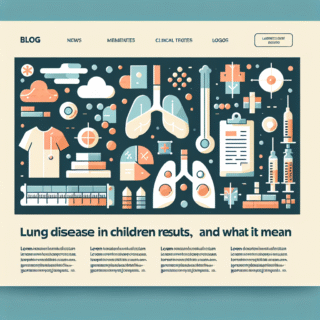
More Allergy, Asthma & Infectious Disease Articles
Lung Disease in Children: Results, Ranges, and What They Mean

Understanding lungs disease in young patients can be frightening for families, but clear results and ranges from common tests help caregivers and clinicians make informed decisions. This article explains how doctors evaluate respiratory complaints, what typical test findings mean, and how to interpret common numbers like oxygen saturation and spirometry percentages. We focus on practical guidance for parents facing childhood lung disease, outlining the most common types and when to seek urgent care.
Types of lung diseases commonly seen in children
Children’s lung disease covers a wide spectrum, from asthma and bronchiolitis to chronic conditions such as cystic fibrosis or bronchopulmonary dysplasia. When clinicians discuss lung disease types they often provide a checklist or list of lung disease possibilities to narrow the problem: viral lower respiratory infections, reactive airways disease (asthma), structural anomalies, immune-related lung disease, and chronic genetic conditions. Knowing the kinds of lung disease helps families anticipate testing and management options.
Tests, typical ranges, and what results mean
Several noninvasive tests give the first clues about lung health:
- Pulse oximetry: Normal oxygen saturation (SpO2) in healthy children is usually 95–100% at sea level. Values under 92% often prompt supplemental oxygen or hospital assessment, depending on symptoms.
- Spirometry (pulmonary function testing): For school-age children able to perform the test, results are reported as percent predicted. An FEV1 (forced expiratory volume in 1 second) above 80% of predicted is generally considered normal; 60–80% suggests mild to moderate obstruction; below 60% indicates more significant impairment.
- Chest X-ray and CT: Radiology reports use descriptive terms (hyperinflation, consolidation, bronchial wall thickening). Findings are interpreted alongside clinical signs—an X-ray alone rarely gives a definitive diagnosis for many childhood lung disease presentations.
- Blood gases: In severe illness, arterial or capillary blood gases show oxygen (PaO2) and carbon dioxide (PaCO2) levels. Elevated CO2 can indicate inadequate ventilation and need for urgent support.
- Allergy testing and sputum cultures: These clarify triggers or infections, especially important in recurrent wheeze or persistent cough.
Interpreting results for different ages
Infants and toddlers often cannot perform spirometry, so providers rely more on oxygen saturations, clinical exam, and imaging. For adolescents, adult-style spirometry ranges are used but adjusted for height, age, and sex (percent predicted). In neonates and preterm infants, reference ranges differ and specialists consider corrected gestational age when assessing lung function.
Treatment decisions based on ranges and patterns
Mild abnormalities may be managed outpatient with inhaled bronchodilators, controller medications, or antibiotics if a bacterial infection is suspected. Recurrent abnormal spirometry or evidence of chronic disease prompts referral to a pediatric pulmonologist for further workup (cystic fibrosis testing, high-resolution CT, immunology). Preventive measures for chronic lung disease in children include vaccinations, avoidance of tobacco smoke and pollutants, and adherence to prescribed asthma action plans.
When symptoms overlap with ENT conditions
Cough, sinus pressure, and facial pain can blur the line between airway and ear/nose/throat problems; sometimes sinusitis produces symptoms that mimic respiratory disease or causes referred dental pain. For a practical look at how sinus problems can affect related symptoms, see this article on sinusitis and dental pain to learn more about overlapping presentations and when to seek ENT evaluation: Could your dental pain be caused by sinusitis?
For reliable guidance on asthma in children and evidence-based recommendations, the Centers for Disease Control and Prevention provides a helpful overview on pediatric asthma care and prevention measures: CDC — Asthma in Children.
Prevention and home care
Simple interventions reduce risk: ensure routine immunizations (influenza and COVID-19 where recommended), maintain smoke-free environments, manage allergies proactively, and follow action plans for known asthma. For chronic conditions, regular specialist follow-up and adherence to therapies can preserve lung function and quality of life.
- Takeaways
- Pulse oximetry and spirometry are cornerstone tests; know the normal ranges for your child’s age and follow up on abnormal values.
- Many cases of lung disease in children are treatable or manageable with medications, lifestyle changes, and monitoring.
- Overlap with ENT conditions can complicate diagnosis—share full symptom details with your clinician and consider ENT referral when pain or sinus symptoms persist.
Q: When should I take my child to the emergency department for breathing trouble?
A: Seek urgent care if your child has sustained breathing difficulty, blue lips or face, very low oxygen saturation if measured (<92%), severe chest retractions, poor responsiveness, or inability to feed. Contact your pediatrician promptly for other concerning but less severe symptoms.
Q: Can my child outgrow asthma or other chronic lung conditions?
A: Some children experience decreased symptoms as they grow, especially with mild asthma, but others have persistent disease. Ongoing evaluation by a pediatrician or pulmonologist helps determine prognosis and long-term management.
Other Articles You May Find of Interest...
- Recognizing the Hidden Signs of a Silent Asthma Attack
- Is Dupixent the Key to Managing Your Asthma Effectively?
- Effective Strategies to Overcome PPP Disease and Regain Your Health
- Uncovering the Triggers of Pericarditis and How to Manage Its Impact
- Do Ticks Jump or Climb? Unraveling the Truth About Tick Behavior
- What Does Purulent Mean and How Does It Impact Your Health?
- Common Diseases That Affect Lung Health and Their Impact














